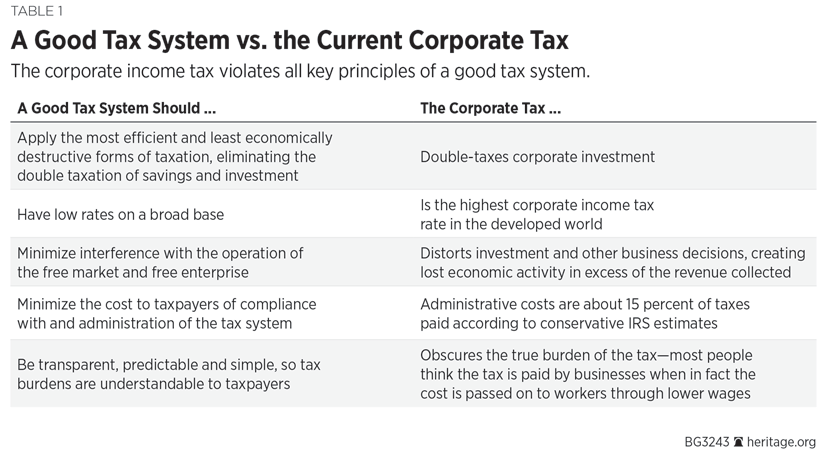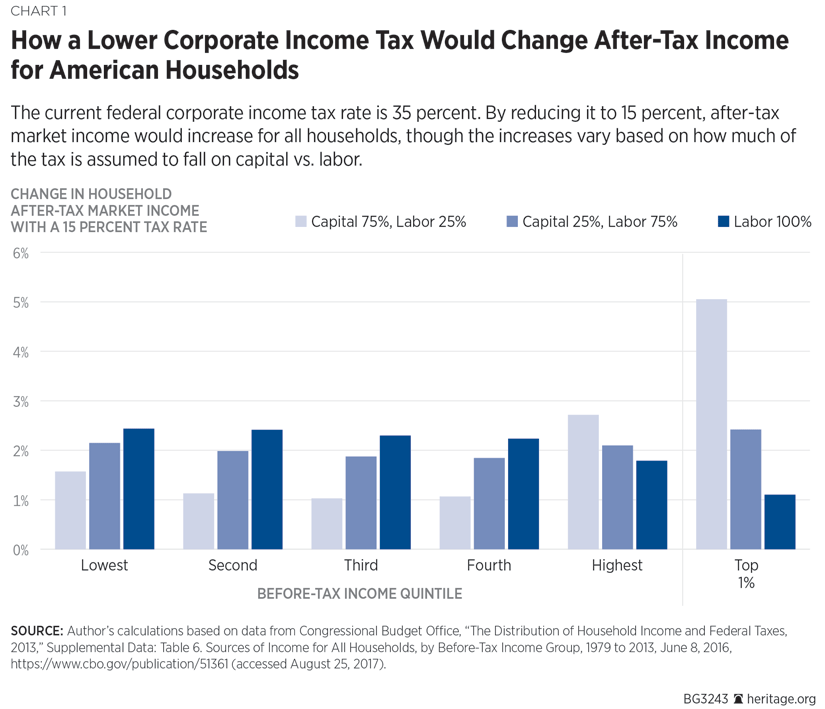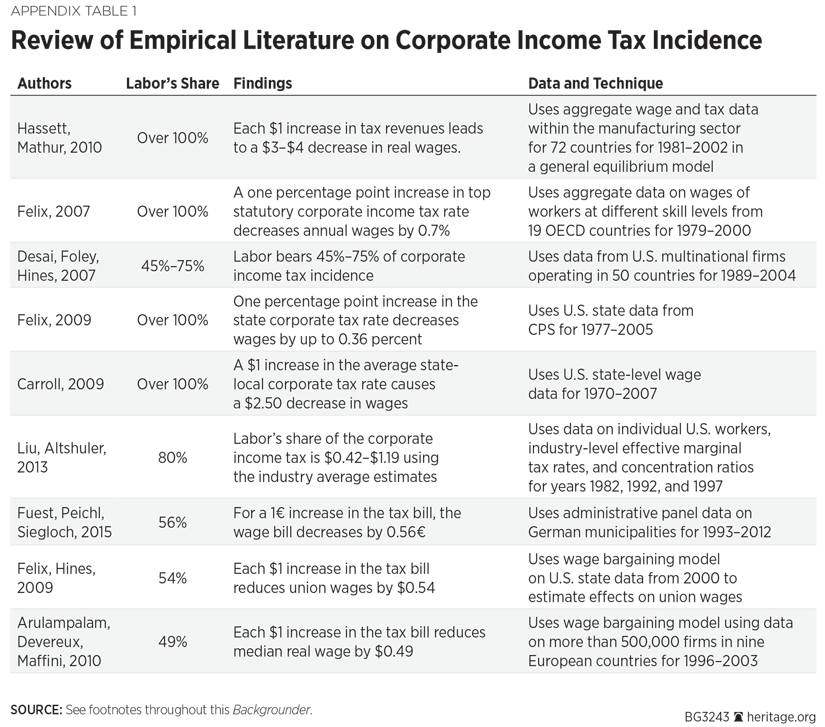As counterintuitive as it may seem, a tax cut for corporations is a tax cut for the average American. This is because corporations are made up of people. Across the U.S., corporations employ 54.8 million hard-working individuals who create products for global and domestic markets.[REF] Corporate profits also are ultimately claimed by people. More than half of Americans invest in the stock market, and almost 40 percent of corporate stock is owned through retirement plans.[REF] A tax on corporate income is therefore a tax on the average American.
By definition, all business taxes must be paid by owners or workers, resulting in less investment income or lower wages. Put differently, all business taxes are passed on to workers or owners, and it turns out that they are mostly passed on to workers. The dominant perspective in Washington seems to be that the corporate income tax is paid by rich people—a common misconception that is based on economic theory developed in the 1960s by an economist who has since reversed his conclusions. A corporate tax rate cut is actually a progressive tax change that benefits workers who earn their income in the form of wages and those at the bottom of the income scale the most.
The most recent economic research shows that workers bear a majority of the economic burden of the corporate income tax in the form of lower wages. Labor bears between 75 percent and 100 percent of the cost of the corporate tax. A 20-point reduction of the corporate income tax to 15 percent would boost the relative market incomes of the poorest Americans by significantly more than it would boost those of the richest. Cutting the corporate income tax is an essential component of tax reform.
The Corporate Income Tax and Tax Reform
The most economically destructive aspects of the current system are taxes levied on corporations. At its core, the corporate income tax is a perverse double tax on the same income that stifles economic growth by artificially increasing the tax rate on savings and investment. Perhaps most insidiously, the tax appears at first glance to fall on the rich and owners of corporations. However, workers pay almost entirely for the corporate income tax through lower wages.
The United States has the highest corporate tax rate in the developed world. The U.S. imposes a top marginal federal corporate income tax rate of 35 percent (38.9 percent when the state average is included). The tax accounts for less than 10 percent of federal revenue.[REF]
Once corporate profits are taxed in the U.S. at the business level, they can be distributed back to the shareholders as dividends or retained for future investments. When the owners of corporate shares realize a gain by receiving a dividend or selling their stock, the U.S. system levies a second tax on that same income through a separate tax on capital gains or dividends. This two-layer tax system complicates the tax code and, according to the U.S. Department of the Treasury, “perversely penalizes the corporate form of organization.”[REF]
The corporate income tax violates all of the key principles of a good tax system. (See Table 1.) The basic principles of a good tax system are straightforward. The tax system should apply the most efficient and least economically destructive forms of taxation; have low rates on a broad base that eliminates the double taxation of investment; and be as transparent, predictable, and simple as possible while respecting the core institutions of civil society and protecting the rights to life, liberty, and property.

The corporate income tax is a poor mechanism for funding the government. Economists agree almost unanimously on this point: The corporate income tax is an inefficient and economically destructive mechanism for raising revenue. The poor design of the tax has led many economists to agree further that the tax should be entirely repealed.[REF] Anemic wage growth, historically sluggish rates of business start-ups, low levels of investment, and reduced economic dynamism are just a few of the myriad reasons why business tax reform must be the centerpiece of congressional efforts to update the tax system.[REF]
How the Corporate Tax Hurts Workers: A History of Thought on Tax Incidence
In today’s open economy, labor bears the cost of revenue raised by the corporate income tax. In the 1960s, economists generally believed the opposite: The corporate tax fell on owners of capital. The economic orthodoxy of corporate tax incidence has since reversed.
In 1962, Arnold Harberger first described the basic rationale for why capital should bear the full cost of corporate taxes in a standard economic framework.[REF] In a simple closed economy—meaning an economy in which there is no intercountry investment—with fixed capital and labor supply, the corporate tax forces capital out of the “corporate” sector and into the “non-corporate” sector, lowering the after-tax rate of return to capital in both sectors.[REF] Under these assumptions, Harberger showed that the return to capital was reduced by the amount of collected tax revenue and that wages remained constant.[REF]
Since the 1960s, the global economy has become significantly more connected. Information costs have fallen dramatically, technology has integrated businesses around the world, international financial markets have flourished, and trade barriers such as tariffs have decreased.[REF] These developments have greatly benefited domestic markets by increasing consumer choice, lowering the cost of products, and raising standards of living.[REF] Increasingly, corporations and their investments can be moved to other countries or other states, especially over time. If Harberger’s original closed-economy assumption is reversed and one assumes a modern open economy in which corporate capital can move to avoid high taxes, the burden of the tax shifts from the owners of capital to labor.
In an open economy where capital can move abroad and the prices of goods are set competitively in the world market, the corporate tax has only one place to shift: to workers. When capital moves abroad, the domestic capital-to-labor ratio declines, slowing productivity and lowering wages. The global after-tax return to capital is largely unchanged, but because workers are generally not internationally mobile, wages remain depressed in the country with the higher corporate tax and lower levels of investment.
Businesses invest so that their employees can be more productive. More productive employees earn higher wages and produce more output, and businesses can hire additional workers as profit, investment, and demand increase. Because labor supply is constrained by relatively fixed variables like population size, an increase in capital investments allows wages to be bid up as labor becomes relatively scarce compared to the expanded capital stock. This is the basic logic of why higher capital-to-labor ratios (that is, more capital per worker) benefit workers. More concretely, the data suggest that an 8 percent increase in capital per worker would increase wages by 13 percent to 20 percent.[REF] Due to this dynamic, in the open-economy model where capital can escape high tax rates, labor bears the full burden of the corporate tax.
In 1995 and again in 2008, Harberger revisited his seminal 1962 contribution, ultimately reversing his initial analysis. He concluded that in the modern global world, the economy is open and labor “must end up bearing more than the full burden of the tax.”[REF] The empirical literature supports Harberger’s revised conclusions: Workers bear the full economic burden of the corporate income tax. This analysis certainly does not conclude that a closed economy or impediments to capital or labor mobility would benefit workers or wages. Instead, the changing economic landscape increasingly makes the corporate income tax a harmful relic of the past, designed for a different time, and one that should be repealed because its costs are higher than its benefits.
A complete analysis should also take into account the economic inefficiencies caused by tax-induced misallocation of resources. Economic models show that the inefficiency or “deadweight loss” of the corporate income tax can be as high as 150 percent of revenue raised.[REF] Empirical estimates of the economic loss support the model results, suggesting that the tax can depress wages by more than two times and as much as four times the amount of revenue raised.[REF]
Higher Corporate Taxes, Lower Wages
Corporate taxes reduce domestic wages. Most empirical estimates conclude that labor bears between 75 percent and 100 percent of the tax burden, with results in the literature ranging from 45 percent to 420 percent. For many years, the question of who will bear the corporate income tax was answered by calibrating models with assumptions about the economy. More recently, a growing body of research has begun to estimate the incidence and burden of the corporate income tax directly. No one study or model is perfect, but the sum of the literature generally shows that labor bears a majority and increasing share of the corporate tax.
The largest group of studies investigates the full economic burden of the corporate income tax, taking into account the revenue costs and economic inefficiencies. Summarized in Appendix Table 1, this group of studies estimates the effect of changes in corporate tax rates using variation between countries, U.S. states, and over time. The data show considerable evidence that the corporate income tax significantly reduces wages. For example, Kevin Hassett and Aparna Mathur use aggregate manufacturing wage and tax data for 72 countries from 1981 to 2002. They find that a $1 increase in tax revenues is associated with a $3-to-$4 decrease in real wages, implying that labor can bear up to 400 percent of the corporate tax.[REF] More recent evidence from Li Liu and Rosanne Altshuler uses individual U.S. worker data, industry-level effective marginal tax rates, and capital-to-labor concentration ratios to show that labor bears an average estimated 80 percent of the tax, and up to 119 percent.[REF]
A second group of empirical research finds smaller estimates for labor’s share of the corporate income tax. This group of studies uses wage bargaining models to assess how a firm’s profits are divided between labor and capital.[REF] Among this group, the incidence is estimated to be between 50 percent and 60 percent, the larger share falling on labor.[REF] These estimates should be interpreted with caution as they measure the direct effects of changes in tax liability through one channel and do not include other channels or the indirect full adjustment effect of changes in prices or capital stock. An incidence of 60 percent, passed on through just one channel, is compelling evidence that labor bears a much larger share of the total tax burden.
So How Open Is the Economy?
The debate over who bears the burden of the corporate income tax invariably turns on one question: How open is the U.S. economy?[REF] Those who are skeptical about the view that labor bears a large share of the tax discount the empirical evidence, citing various research design limitations.[REF] They maintain that the economy is relatively closed and that capital must therefore bear a significant share of the corporate tax.[REF] The open or closed economy assumption informs how Harberger-style models are calibrated, which dramatically changes the predicted burdens of the corporate tax. In an open economy model with internationally mobile capital, the economic burden of the corporate income tax falls unambiguously on labor.[REF]
The openness of the economy has been distilled to the issue of capital mobility: How readily do investors reallocate their capital investments between countries based on differences in rates of return due to tax or other economic factors? Economists have answered this question in three different ways: by measuring the effect of tax changes on foreign direct investment, by measuring the correlation between domestic savings and investment, and through the body of research already presented that measures the burden of the corporate income tax and infers capital mobility from the estimates.[REF]
The research on foreign direct investment strongly supports the hypothesis that the economy is open and that capital flows freely to its most highly valued use. In a summary of this body of research, George Zodrow notes that “the empirical literature as a whole suggests that international capital is quite mobile and in particular is significantly affected by tax factors.”[REF]
The second strand of literature estimates the openness of an economy by measuring the correlation between domestic saving and domestic investment. This was first investigated in 1980 by Martin Feldstein and Charles Horioka, who posited that if domestic saving and investment have a correlation of one, the economy must be completely closed—showing that every dollar of savings is invested in the home country, with no capital flows abroad.[REF] This is the research that is often cited as evidence that global economies are relatively closed.[REF] However, a closer reading of the full body of research is inconclusive in answering the question of how open the economy is. Some have questioned Feldstein and Horioka’s underlying assumption, and others find very different estimates under different specifications.[REF] If anything, the literature is in agreement that the U.S. economy continues to be more open every year.
All studies that investigate capital mobility over time find evidence that capital has become more mobile. The literature on the burden of the corporate income tax finds that labor’s share of the tax has trended upward over time.[REF] The literature on foreign direct investment shows that capital has become more mobile over time.[REF] In a review of five different economic trends that contribute to labor bearing an increasing portion of the corporate income tax, Jason Fichtner and Jacob Feldman conclude “that the sensitivity of US businesses to corporate taxation is increasing and that the amount of capital invested in the United States may further decrease in the long term as a result.”[REF] This research presents compelling evidence that labor will continue to shoulder a larger share of the corporate income tax as the global economy continues to become more integrated.
The current status of the economic literature supports the opposite of the original 1980s analysis. It should now be considered appropriate, at least in approximation, to study tax burdens with models that assume perfect international capital mobility.
Outdated Government Incidence Assumptions
Government modeling assumptions bias the benefits of corporate tax reform toward the wealthy and do not account properly for the benefits that accrue to lower-wage earners. The estimates allocate an improbably high portion of the tax to capital in refutation of the economic literature. The Joint Committee on Taxation’s analysis relies heavily on estimates from calibrated models, assuming a relatively closed economy, and discounts the empirical literature.[REF]
The three government entities that score tax changes and distribute the incidence of the corporate tax to income groups are the Joint Committee on Taxation (JCT), the U.S. Department of the Treasury’s Office of Tax Analysis (OTA), and the Congressional Budget Office (CBO). In the past, the JCT has eliminated the incidence of the corporate income tax from its distribution analysis to avoid the controversial issue of determining who bears the true burden. This has the unfortunate side effect of making an increase in the corporate-tax rate look as if it has no effect on after-tax incomes. In the past, the Treasury, CBO, and JCT have allocated 100 percent of the corporate income tax to owners of capital, following Harberger’s 1962 analysis. They have since revised their analyses, acknowledging that labor bears some share of the corporate tax burden. The CBO and JCT both currently allocate 75 percent of the corporate income tax to owners of capital, and OTA research distributes 82 percent to capital.[REF]
Assumptions Matter for Distributional Analysis
If the corporate tax rate was cut by 20 points from 35 percent to 15 percent, no matter the assumed incidence of the tax, every American would see increased after-tax incomes. Even under the assumption that owners of capital bear 80 percent of the burden, all income groups still see increases in their after-tax incomes, according to the Tax Policy Center, an organization that is similar to government scorekeepers in its tax-modeling assumptions.[REF]
Changing the assumption of who bears the tax significantly changes the distributional benefit. Chart 1 shows that under the standard government assumption as outlined by the JCT and CBO, a corporate tax cut with 75 percent of the benefit flowing to capital raises the relative after-tax incomes of the top quintile and the top 1 percent by the largest amount.
Under two revised estimates, Chart 1 also shows that if the benefit flows primarily to labor, the distributional benefits reverse. Following the tax burden literature, it is not unreasonable to assume that 100 percent of the rate cut will accrue to labor income in the long run. A more conservative estimate assumes that only 75 percent of the benefit accrues to labor. Under the conservative estimate (the middle bar in Chart 1), all quintiles see about the same percentage increase in after-tax income. If labor bears 100 percent of the incidence of the corporate tax, a cut in the corporate income tax is a progressive tax change as a percentage of income. Shown by the right-hand bar in Chart 1, a cut in the corporate income tax benefits the rich the least.

These estimates should be interpreted as showing how the distribution changes under different assumptions and not as robust results from a full economic model. These numbers also do not include the economic growth resulting from the tax change, which would further boost incomes, doubling or even tripling the above estimates. The results are comparable in magnitude to other estimates with similar assumptions. A Tax Foundation analysis, assuming that labor bears 70 percent of the tax and incorporating economic growth, shows that a 15 percent corporate tax rate would increase average after-tax income by 4 percent, distributed almost evenly across income groups.[REF]
Many analyses of a corporate income tax cut claim that “70 percent of the benefit of a corporate rate cut will flow to the top fifth of households.”[REF] This is misleading for two reasons.
First, the estimates almost always rely on the assumption that capital stands to benefit the most from a tax cut. More than 50 percent of Americans are owners of corporate capital, but the total value is more concentrated in upper quintiles. Under the model presented above, if capital bears 75 percent of the burden, 56 percent of the total benefit will flow to the top one-fifth of households. Under the assumption that labor bears 100 percent of the benefit, the top one-fifth captures only 37 percent.
Second, cumulative statistics are also misleading in a more fundamental way. Presenting almost any tax change in absolute dollar amounts or as a percentage of the total tax cut will skew the results toward the wealthy. The wealthy, by definition, earn a larger share of national income. So if everyone’s tax rate is cut by the same percentage, the wealthy will see a larger absolute increase in after-tax income. A more accurate presentation would show the reform as a percentage of household income. This metric contextualizes the benefit as real taxpayers will experience the reform in relation to their current earnings.
A household in the bottom one-fifth of the earners would see a $365 increase in wages (a 2.4 percent increase) under the scenario presented above. A household in the top one-fifth would see a $3,276 increase in wage income, but as a percentage of total income, this is only a 1.8 percent increase. Simply because the wealthy have larger base incomes, they will see a larger dollar value increase, but relative to total market income, the poorest Americans see the largest increase in take-home pay.
It simply does not make sense to deny a family earning $16,000 ($24,000 including government assistance) a 2.4 percent increase in after-tax market income just because the richest percentile will capture 37 percent of the total dollar value of the reform (a 1.8 percent increase). The top 1 percent see an even smaller increase of only 1.1 percent.
Conclusion
The preponderance of evidence shows that the corporate tax harms workers through lower wages. Because the U.S. has a relatively open economy, the tax is shifted from owners of capital to workers, the suppliers of labor. The corporate income tax artificially pushes capital abroad, causing large inefficiencies that cost the economy in productivity and cost workers through lower wages. These inefficiencies are estimated to be significantly larger than the revenue generated by the tax.
A tax that causes economic costs in excess of the revenue generated is a poor mechanism for funding the government. Economists agree almost unanimously on this point: The corporate income tax is an inefficient and economically destructive mechanism for raising revenue. The poor design of the tax has led many economists to agree that the tax should be repealed entirely.
In tax reform, there are innumerable reasons to lower or eliminate the corporate income tax. The most notable reason that proponents of the tax give for keeping the corporate income tax at internationally high levels is distributional fairness. They claim that cutting the corporate income tax will disproportionately benefit the rich. But the economic literature shows the opposite: The average American household will share the benefits of a corporate rate cut through higher wages. In the most optimistic scenario supported by the economic literature, a corporate tax rate cut is progressive, benefiting those at the bottom of the income distribution the most.
—Adam N. Michel is a Policy Analyst in Tax and Budget Policy in the Thomas A. Roe Institute for Economic Policy Studies, of the Institute for Economic Freedom, at the Heritage Foundation.
Appendix


